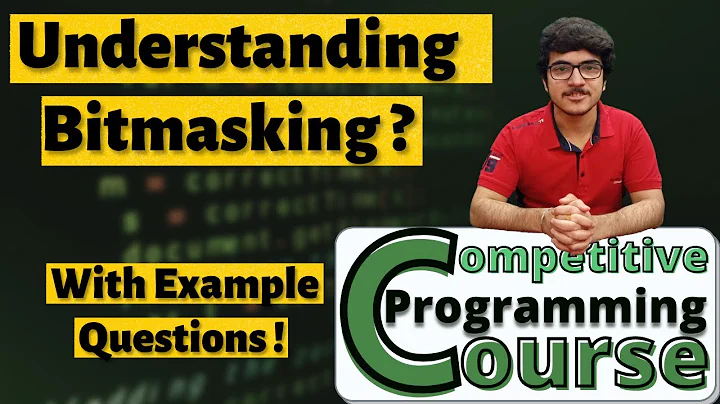What is Bit Masking?
Solution 1
A mask defines which bits you want to keep, and which bits you want to clear.
Masking is the act of applying a mask to a value. This is accomplished by doing:
- Bitwise ANDing in order to extract a subset of the bits in the value
- Bitwise ORing in order to set a subset of the bits in the value
- Bitwise XORing in order to toggle a subset of the bits in the value
Below is an example of extracting a subset of the bits in the value:
Mask: 00001111b
Value: 01010101b
Applying the mask to the value means that we want to clear the first (higher) 4 bits, and keep the last (lower) 4 bits. Thus we have extracted the lower 4 bits. The result is:
Mask: 00001111b
Value: 01010101b
Result: 00000101b
Masking is implemented using AND, so in C we get:
uint8_t stuff(...) {
uint8_t mask = 0x0f; // 00001111b
uint8_t value = 0x55; // 01010101b
return mask & value;
}
Here is a fairly common use-case: Extracting individual bytes from a larger word. We define the high-order bits in the word as the first byte. We use two operators for this, &, and >> (shift right). This is how we can extract the four bytes from a 32-bit integer:
void more_stuff(uint32_t value) { // Example value: 0x01020304
uint32_t byte1 = (value >> 24); // 0x01020304 >> 24 is 0x01 so
// no masking is necessary
uint32_t byte2 = (value >> 16) & 0xff; // 0x01020304 >> 16 is 0x0102 so
// we must mask to get 0x02
uint32_t byte3 = (value >> 8) & 0xff; // 0x01020304 >> 8 is 0x010203 so
// we must mask to get 0x03
uint32_t byte4 = value & 0xff; // here we only mask, no shifting
// is necessary
...
}
Notice that you could switch the order of the operators above, you could first do the mask, then the shift. The results are the same, but now you would have to use a different mask:
uint32_t byte3 = (value & 0xff00) >> 8;
Solution 2
Masking means to keep/change/remove a desired part of information. Lets see an image-masking operation; like- this masking operation is removing any thing that is not skin-
We are doing AND operation in this example. There are also other masking operators- OR, XOR.
Bit-Masking means imposing mask over bits. Here is a bit-masking with AND-
1 1 1 0 1 1 0 1 [input] (&) 0 0 1 1 1 1 0 0 [mask] ------------------------------ 0 0 1 0 1 1 0 0 [output]
So, only the middle 4 bits (as these bits are 1 in this mask) remain.
Lets see this with XOR-
1 1 1 0 1 1 0 1 [input] (^) 0 0 1 1 1 1 0 0 [mask] ------------------------------ 1 1 0 1 0 0 0 1 [output]
Now, the middle 4 bits are flipped (1 became 0, 0 became 1).
So, using bit-mask we can access individual bits [examples]. Sometimes, this technique may also be used for improving performance. Take this for example-
bool isOdd(int i) {
return i%2;
}
This function tells if an integer is odd/even. We can achieve the same result with more efficiency using bit-mask-
bool isOdd(int i) {
return i&1;
}
Short Explanation: If the least significant bit of a binary number is 1 then it is odd; for 0 it will be even. So, by doing AND with 1 we are removing all other bits except for the least significant bit i.e.:
55 -> 0 0 1 1 0 1 1 1 [input] (&) 1 -> 0 0 0 0 0 0 0 1 [mask] --------------------------------------- 1 <- 0 0 0 0 0 0 0 1 [output]
Related videos on Youtube
Mr.Z
Updated on July 08, 2022Comments
-
Mr.Z almost 2 years
I am fairly new to C programming, and I encountered bit masking. Can someone explain to me the general concept and function of bit masking? Examples are much appreciated.
-
 pevik about 7 yearsI know links should not be posted, but wikipedia explanation is great: en.wikipedia.org/wiki/Mask_(computing)
pevik about 7 yearsI know links should not be posted, but wikipedia explanation is great: en.wikipedia.org/wiki/Mask_(computing)
-
-
Paul R almost 12 yearsGood answer but masking can also be applied for setting or toggling specific bits with OR or XOR operations and a suitable mask.
-
Paul R almost 12 years@Mr.Z: in C, C++ and related languages you would you the bitwise AND operator, which is written as
&. -
 Lundin almost 12 years@Mr.Z For example: clear one byte of a uint32_t by masking the contents away:
Lundin almost 12 years@Mr.Z For example: clear one byte of a uint32_t by masking the contents away:#define MASK 0x000000FF .... my_uint32_t &= ~MASK. -
Ungeheuer almost 7 yearsthe
bto indicate binary literal is not supported by all compilers, correct? -
 Harshit Sharma about 5 yearsAlso, to convert an integer to an odd no. if it is an even number: i=i|1. This comes in handy when we are trying to generate a sequence like 1, 3, 5,..., 2, 4, 6,...
Harshit Sharma about 5 yearsAlso, to convert an integer to an odd no. if it is an even number: i=i|1. This comes in handy when we are trying to generate a sequence like 1, 3, 5,..., 2, 4, 6,... -
 Harshit Sharma about 5 yearsYou can also use the following operation to find the number with only the least significant bit from an integer: lsb = i&-i
Harshit Sharma about 5 yearsYou can also use the following operation to find the number with only the least significant bit from an integer: lsb = i&-i -
nurabha almost 5 yearsA part of confusion arises possibly because of poor choice of noun and verbs to describe what is really going on. For example, wouldn't a word like "Bitselector" or "TargetBits" seem more suitable word to describe the object instead of using the word "Bitmask" ? Similarly, to describe the bit manipulation operations, using word such as "BitManipulate" seems more suitable word than the word "Masking" as the latter only makes sense for AND operations but not for XORING (toggle bits) or OR (set bits) which are rather bit manipulations or transformations but not masking operation.
-
Margach Chris over 4 yearsso a mask is a byte used in a bitwise operation? why call it a "mask?"
-
Jerry An about 3 years
-
 Naman Durve about 2 yearsSuppose I used a bit mask in this way " if (value & 0x0F) ". And, suppose if I wanted to use this 'value' variable later, what would the variable 'value' contain? Will it contain it's original data or altered data after the masking operation?
Naman Durve about 2 yearsSuppose I used a bit mask in this way " if (value & 0x0F) ". And, suppose if I wanted to use this 'value' variable later, what would the variable 'value' contain? Will it contain it's original data or altered data after the masking operation?






